|
 Clavaria subviolacea Clavaria subviolacea
BiostatusPresent in region - Indigenous. Endemic
Images (click to enlarge)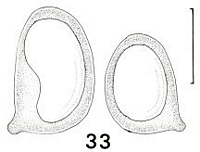
Caption: Fig. 33 Clavaria subviolacea, spores. Horak no. 1030 (ZT). Scalebar=5 µm. | 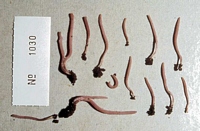
Caption: Microfiche 1-26. Clavaria subviolacea. Horak no. 1030. | 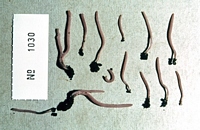
Caption: 1030, id. R. Petersen, label 50x10mm, NZ, NI, Auckland, Waitakere R., Huia, Karamatura Stream, on soil in
broadleaf-conifer forest, 01.07.1981, leg. EH
Owner: E. Horak | 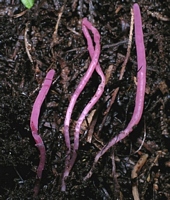
Owner: J.A. Cooper | 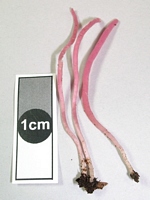
Owner: J.A. Cooper |
Article: Petersen, R.H. (1988). The clavarioid fungi of New Zealand. New Zealand Department of Scientific and Industrial Research, Bulletin 236: 170 pp. Wellington:.
Description: Fruit bodies up to 35 x 3 mm, simple clubs, scattered to cespitose in small groups, narrowly
fusiform. Club equal, dull violaceous ("livid brown") in youth and maturity, opaque,
appearing waxy; flesh concolourous; apex rounded. Stipe equal to tapering slightly
downward, concolourous with club or paler ("pale greyish vinaceous"), inserted nakedly.
Taste and odour negligible.
Tramal hyphae of club 2-8 µm diam., uninflated, clampless, hyaline, thin- to slightly thick-walled (wall up to 0.2 µm thick), strictly
parallel, adherent. Subhymenium extensive, pseudoparenchymatous; hymenium thickening, basidia 40-50 x 7-9 µm, broadly clavate,
bifurcate or clamped, obscurely refringent, empty but persistent after spore discharge;
sterigmata 4, curved-ascending.
Spores 6.5-8.3 x 4.7-5.4 µm (E= 1.29-1.67; Em = 1.47; Lm = 7.27 µm), narrowly ovate to
ellipsoid, hyaline, thin-walled; contents uniguttulate when mature; hilar appendix small, papillate.
Notes: Fruit body colours and stature are similar to those of Clavaria roseo-violacea, but
basidiospores are different and basidia are shorter.
|